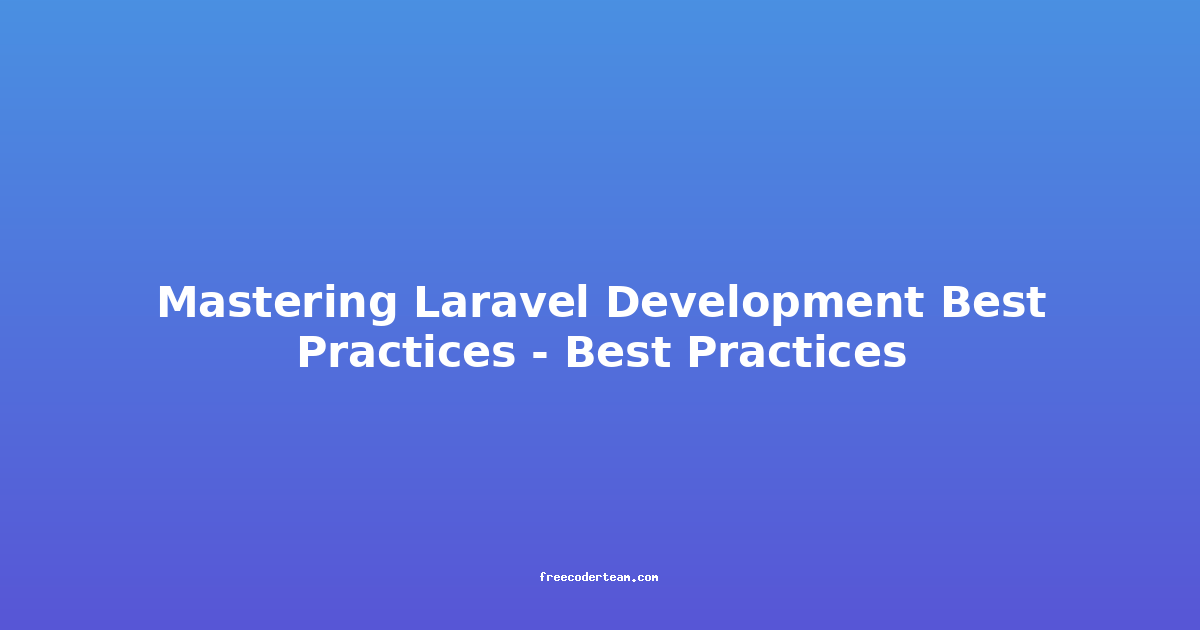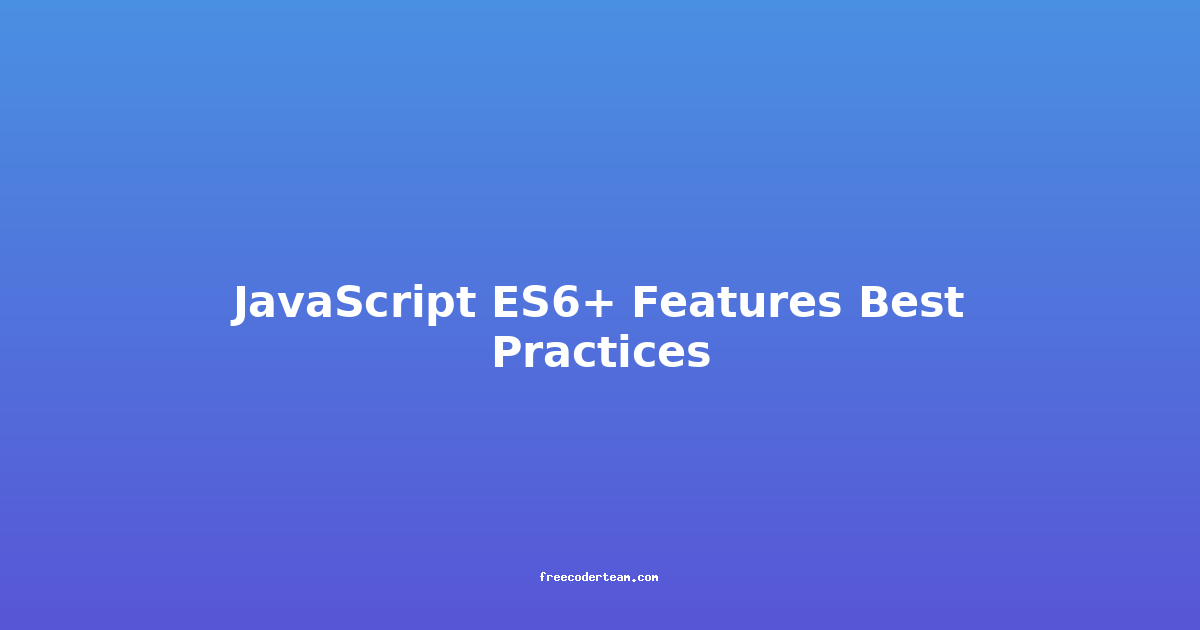Mastering Laravel Development Best Practices
Laravel is one of the most popular PHP frameworks, known for its simplicity, elegance, and robust features. However, even the most powerful tools can be misused if not handled with care. To truly harness the potential of Laravel, developers must adopt best practices that not only streamline development but also ensure maintainability, security, and scalability.
In this blog post, we'll explore key best practices for Laravel development. We'll cover everything from project organization to security measures, with actionable insights and practical examples to help you master Laravel development.
Table of Contents
- 1. Project Structure and Organization
- 2. Code Conventions and Standards
- 3. Dependency Injection and Service Providers
- 4. Use of Eloquent and Query Builder
- 5. Security Best Practices
- 6. Performance Optimization
- 7. Testing and Continuous Integration
- 8. Documentation and Maintainability
- 9. Conclusion
1. Project Structure and Organization
A well-organized Laravel project is essential for maintainability and scalability. Laravel provides a solid directory structure out of the box, but you can further enhance it by following these best practices:
Subsection: Organize Features Using Feature Folders
Rather than scattering controllers, models, views, and migrations across different directories, group them by feature. For example, if you have a "User Management" feature, create a User folder within app and place all related components there.
Example:
app/
├── Features/
│ ├── User/
│ │ ├── User.php (Model)
│ │ ├── UserController.php (Controller)
│ │ ├── UserRequest.php (Validation Request)
│ │ └── UserPolicy.php (Policy)
│ └── Post/
│ ├── Post.php (Model)
│ ├── PostController.php (Controller)
│ └── PostRequest.php (Validation Request)
This approach makes it easier to navigate and manage related components.
Subsection: Use Artisan Commands for File Generation
Laravel's artisan command is a powerful tool for generating files. Instead of manually creating files, use commands to ensure consistency and adherence to Laravel's conventions.
Example:
php artisan make:model User -mcr
This command generates:
- A model (
User.php) - A migration (
create_users_table.php) - A controller (
UserController.php)
2. Code Conventions and Standards
Adhering to coding standards ensures consistency and readability across your codebase. Laravel's official documentation recommends following PSR-12.
Subsection: Use IDE Tools for Code Formatting
Most modern IDEs, such as VS Code and PhpStorm, support PHP coding standards. Install plugins like PHP CS Fixer to automatically format your code.
Example:
php-cs-fixer fix
Subsection: Consistent Naming Conventions
- Controllers: Use
Controllersuffix (e.g.,UserController). - Models: Use singular names (e.g.,
Userinstead ofUsers). - Views: Use descriptive names and organize them by feature (e.g.,
resources/views/user/index.blade.php).
3. Dependency Injection and Service Providers
Dependency Injection (DI) is a core concept in Laravel that promotes loose coupling and testability. Instead of creating objects manually, Laravel's service container handles object creation and dependencies.
Subsection: Use Constructor Injection
Inject dependencies into controllers or services through the constructor. This makes dependencies explicit and easier to manage.
Example:
namespace App\Http\Controllers;
use App\Services\UserService;
class UserController
{
protected $userService;
public function __construct(UserService $userService)
{
$this->userService = $userService;
}
public function index()
{
$users = $this->userService->getAllUsers();
return view('user.index', compact('users'));
}
}
Subsection: Leverage Service Providers
Service providers are a centralized way to register services, bindings, and events. Use them to organize your application's dependencies.
Example:
namespace App\Providers;
use Illuminate\Support\ServiceProvider;
use App\Services\UserService;
class UserServiceProvider extends ServiceProvider
{
public function register()
{
$this->app->bind(UserService::class, function ($app) {
return new UserService($app->make('UserRepository'));
});
}
}
4. Use of Eloquent and Query Builder
Laravel's Eloquent ORM and Query Builder provide powerful tools for interacting with databases. Use them effectively to write clean and efficient queries.
Subsection: Leverage Eloquent Relationships
Define relationships between models using Eloquent's built-in methods like hasOne, hasMany, belongsTo, and belongsToMany. This reduces the need for manual joins and makes your code more maintainable.
Example:
namespace App\Models;
use Illuminate\Database\Eloquent\Model;
class Post extends Model
{
public function user()
{
return $this->belongsTo(User::class);
}
public function comments()
{
return $this->hasMany(Comment::class);
}
}
Subsection: Use Query Scopes for Reusable Queries
Query scopes allow you to define reusable query patterns. For example, you can create a scope to fetch active users.
Example:
namespace App\Models;
use Illuminate\Database\Eloquent\Model;
class User extends Model
{
public function scopeActive($query)
{
return $query->where('status', 'active');
}
}
// Usage
$activeUsers = User::active()->get();
5. Security Best Practices
Security is paramount, especially in web applications. Laravel provides robust tools to help you secure your application.
Subsection: Validate User Input
Always validate user input using Laravel's validation feature. This prevents SQL injection, XSS, and other vulnerabilities.
Example:
namespace App\Http\Requests;
use Illuminate\Foundation\Http\FormRequest;
class StoreUserRequest extends FormRequest
{
public function rules()
{
return [
'name' => 'required|string|max:255',
'email' => 'required|email|unique:users',
'password' => 'required|string|min:8|confirmed',
];
}
}
Subsection: Use CSRF Protection
Laravel automatically includes CSRF protection in forms. Ensure that all forms include the @csrf directive.
Example:
<form method="POST" action="/users">
@csrf
<input type="text" name="name" />
<button type="submit">Submit</button>
</form>
Subsection: Encrypt Sensitive Data
Use Laravel's encryption feature to store sensitive data securely. Avoid storing plaintext passwords or API keys in your database.
Example:
use Illuminate\Support\Facades\Crypt;
// Encrypt
$encrypted = Crypt::encrypt('sensitive_data');
// Decrypt
$decrypted = Crypt::decrypt($encrypted);
6. Performance Optimization
Optimizing performance ensures your application runs smoothly, even under heavy load.
Subsection: Use Caching
Laravel's caching mechanisms can significantly improve performance. Use the Cache facade to cache frequently accessed data.
Example:
use Illuminate\Support\Facades\Cache;
// Cache for 1 hour
$users = Cache::remember('users', 3600, function () {
return User::all();
});
Subsection: Eager Loading Relationships
To avoid the "N+1 Query Problem," use Eloquent's eager loading to fetch related models in a single query.
Example:
$posts = Post::with('user')->get();
7. Testing and Continuous Integration
Writing tests ensures your application behaves as expected and helps catch bugs early.
Subsection: Write Unit Tests
Use Laravel's integrated testing framework to write unit tests for your models, services, and controllers.
Example:
namespace Tests\Unit;
use Tests\TestCase;
use App\Models\User;
class UserTest extends TestCase
{
public function testUserCreation()
{
$user = User::factory()->create();
$this->assertDatabaseHas('users', [
'name' => $user->name,
'email' => $user->email,
]);
}
}
Subsection: Implement Continuous Integration (CI)
Use CI tools like GitHub Actions or Jenkins to automate testing and deployment. This ensures that your codebase remains stable and free of regressions.
Example: GitHub Actions Workflow:
name: Laravel Tests
on:
push:
branches:
- main
jobs:
test:
runs-on: ubuntu-latest
steps:
- uses: actions/checkout@v2
- name: Setup PHP
uses: shivammathur/setup-php@v2
with:
php-version: '8.1'
- name: Install Dependencies
run: composer install --prefer-dist --no-progress --no-interaction
- name: Run Tests
run: vendor/bin/phpunit
8. Documentation and Maintainability
Good documentation is crucial for long-term maintainability, especially in team environments.
Subsection: Document Code Using PHPDoc
Use PHPDoc to document classes, methods, and variables. This makes your codebase more understandable for other developers.
Example:
/**
* Handle user registration.
*
* @param array $data Array containing user details.
* @return \Illuminate\Http\Response
*/
public function register(array $data)
{
// Registration logic
}
Subsection: Maintain Changelogs
Keep a changelog that documents changes, bug fixes, and new features. This helps team members and users understand the evolution of your application.
Example:
## v1.1.0 (2023-10-01)
- Added user profile update functionality.
- Fixed bug in user login validation.
9. Conclusion
Mastering Laravel development involves more than just writing code—it requires adopting best practices that ensure your application is secure, maintainable, and performant. By following the practices outlined in this blog post, you can build high-quality Laravel applications that scale and adapt to changing requirements.
Remember to:
- Organize your project structure effectively.
- Adhere to coding standards and conventions.
- Leverage Dependency Injection and Eloquent ORM.
- Prioritize security and performance.
- Write tests and automate processes.
- Document your code and maintain a changelog.
By incorporating these best practices into your Laravel development workflow, you'll not only improve your productivity but also build applications that stand the test of time.
Additional Resources:
Happy coding! 🚀




